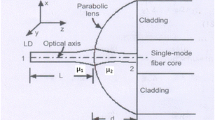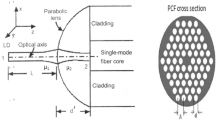Abstract
We report what to our knowledge is the first theoretical prediction of the optimum coupling efficiency of a laser diode emitting two wavelengths either 1.3 or 1.5 µm to a series of circular core graded index single mode fibers with different profile exponents via quadric interface microlens of four different focal lengths on the fiber tip to predict the nature of suitable refractive index profile. Instead of considering special ABCD matrix for individual microlens like hyperbolic, parabolic and elliptical (hemispherical included) one, a simple, accurate, and popular unified transfer ABCD matrix for refraction of quadric microlens under paraxial approximation is utilized to analyze the theoretical coupling efficiency, based on Gaussian beam approximation. Further, it is observed that out of the studied refractive index profiles, the step index profile comes out to be the most suitable profile to couple laser diode to circular core graded index single mode fiber for both wavelengths of practical interest. Moreover, the coupling efficiency can reach nearly 100 % with optimizing structure parameters of specific lensed fiber in both cases. The analysis should find use in ongoing investigations for optimum launch optics for the design of quadric interface microlens either directly on the circular core graded index single mode fiber tip or such fiber attached to single mode fiber.

Similar content being viewed by others
References
E. Li, Characterization of fiber lens. Opt. Lett. 31, 169–171 (2006)
H.M. Presby, C.A. Edwards, Near 100 % efficient fibre microlenses. Electron. Lett. 28, 582–584 (1992)
C.A. Edwards, H.M. Presby, C. Dragone, Ideal microlenses for laser to fiber coupling. J. Lightwave Technol. 11, 252–257 (1993)
J. John, T.S.M. Maclean, H. Ghafouri-Shiraz, J. Niblett, Matching of single-mode fibre to laser diode by microlenses at 1.5 μm wavelength. IEE Proc. Optoelectron. 141, 178–184 (1994)
H.M. Presby, C.A. Edwards, Efficient coupling of polarization maintaining fiber to laser diodes. IEEE Photonics Technol. Lett. 4, 897–899 (1992)
H. Liu, L. Liu, R. Xu, Z. Luan, ABCD matrix for reflection and refraction of Gaussian beams at the surface of a parabola of revolution. Appl. Opt. 44, 4809–4813 (2005)
G.A. Massey, A.E. Siegman, Reflection and refraction of Gaussian light beams at tilted ellipsoidal surfaces. Appl. Opt. 8, 975–978 (1969)
L. Yuan, A. Qui, Analysis of a single-mode fiber with taper lens end. J. Opt. Soc. Am. A 9, 950–952 (1992)
L.B. Yuan, R.L. Shou, Formation and power distribution properties of an upside down taper lens at the end of an optical fiber. Sens. Actuators A21–A23, 1158–1161 (1990)
S. Gangopadhyay, S.N. Sarkar, Laser diode to single-mode fibre excitation via hyperbolic lens on the fibre tip: formulation of ABCD matrix and efficiency computation. Opt. Commun. 132, 55–60 (1996)
S. Gangopadhyay, S.N. Sarkar, ABCD matrix for reflection and refraction of Gaussian light beams at surfaces of hyperboloid of revolution and efficiency computation for laser diode to single-mode fiber coupling by way of a hyperbolic lens on the fiber tip. Appl. Opt. 36, 8582–8586 (1997)
S. Gangopadhyay, S.N. Sarkar, Misalignment considerations in laser diode to single-mode fibre excitation via hyperbolic lens on the fibre tip. Opt. Commun. 146, 104–108 (1998)
S. Gangopadhyay, S.N. Sarkar, Laser diode to single-mode fiber excitation via hemispherical lens on the fiber tip: efficiency computation by ABCD matrix with consideration for allowable aperture. J. Opt. Commun. 19, 42–44 (1998)
S. Gangopadhyay, S.N. Sarkar, Misalignment considerations in laser diode to single-mode fiber excitation via hemispherical lens on the fiber tip. J. Opt. Commun. 19, 217–221 (1998)
H. Liu, The approximate ABCD matrix for a parabolic lens of revolution and its application in calculating the coupling efficiency. Optik 119, 666–670 (2008)
S.K. Mondal, S. Gangopadhyay, S.N. Sarkar, Analysis of an upside-down taper lens end from a single-mode step index fiber. Appl. Opt. 37, 1006–1009 (1998)
S.K. Mondal, S.N. Sarkar, Coupling of a laser diode to single-mode fiber with an upside-down tapered lens end. Appl. Opt. 38, 6272–6277 (1999)
S. Mukhopadhyay, S. Gangopadhyay, S.N. Sarkar, Coupling of a laser diode to a monomode elliptic-core fiber via a hyperbolic microlens on the fiber tip: efficiency computation with the ABCD matrix. Opt. Eng. 46(2), 025008(1-5) (2007)
S. Mukhopadhyay, S. Gangopadhyay, S.N. Sarkar, Misalignment considerations in a laser diode to monomode elliptic core fiber coupling via a hyperbolic microlens on the fiber tip: efficiency computation by the ABCD matrix. Opt. Eng. 46(9), 095008(1-5) (2007)
M.C. Kundu, S. Gangopadhyay, Laser diode to monomode elliptic core fiber excitation via hemispherical lens on the fiber tip: efficiency computation by ABCD matrix with consideration for allowable aperture. Optik 117, 586–590 (2006)
P. Patra, S. Gangopadhyay, K. Goswami, Mismatch considerations in laser diode to monomode fiber excitation via a hemispherical lens on the elliptical core fiber tip. Optik 119, 596–600 (2008)
S. Mukhopadhyay, Laser diode to elliptic-core step index single mode fiber excitation via parabolic microlens on the fiber tip: prediction of coupling efficiency by ABCD matrix formalism. J. Phys. Sci. 20, 159–171 (2015)
S. Mukhopadhyay, S. Gangopadhyay, S.N. Sarkar, Coupling of a laser diode to monomode elliptic core fiber via upside down tapered microlens on the fiber tip: estimation of coupling efficiency with consideration for possible misalignments by ABCD matrix formalism. Optik 121, 142–150 (2010)
S. Mukhopadhyay, S.N. Sarkar, Coupling of a laser diode to single mode circular core graded index fiber via hyperbolic microlens on the fiber tip and identification of the suitable refractive index profile with consideration for possible misalignments. Opt. Eng. 50(4), 045004(1-9) (2011)
A. Bose, S. Gangopadhyay, S.C. Saha, Laser diode to single mode circular core graded index fiber excitation via hemispherical microlens on the fiber tip: identification of suitable refractive index profile for maximum efficiency with consideration for allowable aperture. J. Opt. Commun. 33(1), 15–19 (2012)
S. Mukhopadhyay, Coupling of a laser diode to single mode circular core graded index fiber via parabolic microlens on the fiber tip and identification of the suitable refractive index profile with consideration for possible misalignments. J. Opt. (2016). doi:10.1007/s12596-016-0311-z
S. Mukhopadhyay, Laser diode to circular core graded index single mode fiber excitation via upside down tapered microlens on the fiber tip and identification of the suitable refractive index profile. J. Phys. Sci. 20, 173–187 (2015)
J. Huang, H.J. Yang, ABCD matrix model of quadric interface-lensed fiber and its application in coupling efficiency calculation. Optik 121, 531–534 (2010)
A. Keshavarz, M. Kazempour, Numerical calculation of coupling efficiency for an elegant Hermite-Cosh-Gaussian beams. Int. J. Opt. Photonics 6(2), 75–82 (2012)
S. Mukhopadhyay, Coupling of a laser diode to a quadric interface lensed monomode elliptic-core step index fiber: efficiency computation with the ABCD matrix. J. Opt. 45(2), 167–174 (2016)
R. Tewari, B.P. Pal, Mode excitation by lenses in single mode optical fibers havings graded index profiles. J. Opt. Commun. 6, 25–29 (1985)
D. Marcuse, Gaussian approximation of the fundamental modes of graded index fibers. J. Opt. Soc. Am. 68, 103–109 (1978)
D. Marcuse, Loss analysis of single-mode fiber splices. Bell Syst. Tech. J. 56, 703–718 (1977)
M. Bass, V.N. Mahajan, in Geometrical and Physical Optics, Polarised Light, Components and Instruments, ed. by M. Bass, V.N. Mahajan. Handbook of Optics, vol 1, 3rd edn. (McGraw-Hill, NewYork, 2010) Chapters 22 and 29
S.N. Sarkar, K. Thyagarajan, A. Kumar, Gaussian approximation of the fundamental mode in single mode elliptic core fibers. Opt. Commun. 49, 178–183 (1984)
S.N. Sarkar, B.P. Pal, K. Thyagarajan, Lens coupling of laser diodes to monomode elliptic core fibers. J. Opt. Commun. 7, 92–96 (1986)
A.K. Ghatak, K. Thyagarajan, Optical Electronics, Ch. 13 (Cambridge University Press, Cambridge, 1998), pp. 411–415
Acknowledgment
The author is grateful to University Grants Commission (UGC) for providing financial assistance in a UGC-Minor Research Project (No. PSW-076/14-15 (ERO)).
Author information
Authors and Affiliations
Corresponding author
Appendix
Appendix
The relation between input and output parameters (q 1, q 2) of the light beam is given by
where
with symbols having their usual meanings as already described.
The ray matrix M for the QIML on the tip of the fiber is given by [28–30]
where
where P is the structure parameter of the quadric interface lensed fiber, and L is the working distance which is also the distance of the LD from the microlens.
Again, the refractive index of the material of the microlens with respect to the incident medium is represented by \(\mu ( = {\raise0.7ex\hbox{${\mu_{2} }$} \!\mathord{\left/ {\vphantom {{\mu_{2} } {\mu_{1} }}}\right.\kern-0pt} \!\lower0.7ex\hbox{${\mu_{1} }$}}).\) The transformed beam spot sizes and radii of curvature in the X and Y directions are found by using Eqs. (13a–13d) in Eqs. (10) and (11) and can be expressed as
where
In plane wavefront model, the radius of curvature R 1 of the wavefront from the laser facet → ∞. This leads to A 1 = A and C 1 = C.
Rights and permissions
About this article
Cite this article
Mukhopadhyay, S. Laser diode to circular core graded index single mode fiber excitation via quadric interface microlens on the fiber tip and identification of the suitable refractive index profile for maximum coupling efficiency with optimization of structure parameter. J Opt 46, 359–367 (2017). https://doi.org/10.1007/s12596-016-0358-x
Received:
Accepted:
Published:
Issue Date:
DOI: https://doi.org/10.1007/s12596-016-0358-x




